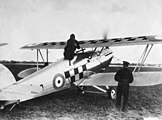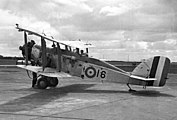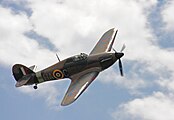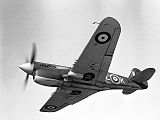4 Squadron SAAF
| 4 Squadron | |
|---|---|
 Supermarine Spitfire Mk.IX | |
| Active | April 1939-December 1939 March 1941-October 1945 January 1951-October 1958 November 1961-September 1991[1] |
| Country |  |
| Branch | South African Air Force |
| Role | Fighter Bomber · Counter Insurgency |
| Motto(s) | "Mors Hosti" (Death to the Enemy)[1] |
| Insignia | |
| Squadron Identification Code | KJ 1942-1945[2] (1942–1943)[3] (Squadron OC: Maj S.F. du Toit flew with personal identification code DUT in 1942-1943[4]) |
| 4 Squadron Insignia |  |
4 Squadron SAAF was a South African Air Force unit which served during World War II.
It was resurrected in 1951 and remained active until 1958. Its final period of active service was from 1961 to 1991. Its final aircraft were Impala Mk IIs. It was based at Lanseria Airport at the time of final disbandment.
History
Establishment and deployment
The squadron was originally equipped with Hawker Hartbees, Hawker Furys and Wapitis when it was first formed in April 1939 in Durban. It was disbanded soon thereafter (December 1939) and resurrected at AFB Waterkloof on 24 March 1941 flying Hurricanes.[1] Operational training took place in Kenya and soon the squadron was responsible for protection against possible Italian attacks from Somaliland. While in Kenya, it received a number of Curtiss Mohawks which had been taken over from French orders.[5]
World War II
On 1 September 1941 the squadron began moving to Egypt and converted to Tomahawks. Its first combat patrol came on 12 November, early in Operation Crusader as a fighter-bomber squadron. The squadron remained in Egypt to take part in all of the desert battles from Operation Crusader to El Alamein. The squadron also supported the advance into Tunisia as well as the invasions of Sicily and Italy. The Kittyhawks were replaced by Spitfires in July 1943. In August it moved on to Sicily and to the Italian mainland in September from where it concentrated on ground attack missions until the end of hostilities. 4 Squadron remained in Italy for two months after the end of the war; on 12 July its personnel began returning to South Africa. The squadron was disbanded in October 1945.[5]
Post World War II
4 Squadron was reformed in January 1951 at AFB Waterkloof as the Active Citizen Force element of 1 Squadron with Harvards and Spitfires until once again disbanded in October 1958. On 1 November 1961, it was reformed at Swartkop, flying Harvards and in August 1972 the first Impala Jets were received.
The squadron moved from Swartkop to Waterkloof and then to Lanseria Airport, where it received Impala Mk IIs. It saw numerous deployments to South-West Africa and Mpacha and Rundu airfields in southern Angola.[6] Its home base remained at Lanseria until it was disbanded in September 1991.[1]
Aircraft
Note: Aircraft type photographs may not necessarily represent aircraft of the same mark or actual aircraft belonging to the squadron.
-
 Hawker Hartbeest
Hawker Hartbeest
1939 -
 Hawker Fury
Hawker Fury
1939 -
 Westland Wapiti
Westland Wapiti
1939 -
 Hawker Hurricane
Hawker Hurricane
1941 -
 Curtiss 87A Kittyhawk
Curtiss 87A Kittyhawk
1941-1943 -
 Captured Messerschmitt Bf 109F
Captured Messerschmitt Bf 109F
North Africa, 1943 -
 Supermarine Spitfire Mk.V
Supermarine Spitfire Mk.V
1943-1945, 1951-1958 -
 North American T-6 Harvard
North American T-6 Harvard
1951-1958, 1961-1972 -
 Atlas Impala Mk I
Atlas Impala Mk I
1972-1991 -
 Atlas Impala Mk II
Atlas Impala Mk II
c. 1980-1991
See also
References
- Footnotes
- Citations
- ^ a b c d "The Airforce - Squadrons". 4 Squadron. Retrieved September 14, 2011.
- ^ Flintham, Vic (2003). Combat Codes. Barnesly: Pen & Sword Aviation. p. 165. ISBN 978-1-84415-691-7.
- ^ Martin, H.J.; Orpen, N.D. (1978). Eagles Victorious: South African Forces World War II. Cape Town: Purnell. p. 44. ISBN 0-86843-008-0.
- ^ Flintham, Vic (2003). Combat Codes. Barnesly: Pen & Sword Aviation. p. 229. ISBN 978-1-84415-691-7.
- ^ a b Rickard, J. "History of War". No. 4 Squadron (SAAF): Second World War. Retrieved September 14, 2011.
- ^ Cooper, Tom (2 September 2003). "Angola: SAAF Bushwacks Six Helicopters". Central, Eastern and Southern Africa Database: Angola. Air Combat Information Unit. Archived from the original on 1 December 2011. Retrieved 14 September 2011.
Bibliography
- Agar-Hamilton, J.A.I.; Turner, L.F.C. (1952). Crisis in the Desert: May – July 1942. Vol. II (1st ed.). Cape Town: Oxford University Press.
- Brown, James Ambrose (1970). A Gathering of Eagles: South African Forces World War II: Volume II. Cape Town: Purnell.
- Brown, James Ambrose (1974). Eagles Strike: South African Forces World War II: Volume IV. Cape Town: Purnell. ISBN 0-360-00196-3.
- Brown, James Ambrose (1990). The War of a Hundred Days:Springboks in Somalia and Abyssinia 1940-1941. Rivonia: Ashanti. ISBN 1-874800-10-3.
- Playfair, I.S.O.; with Stitt, G.M.S; Molony, C.J.C. & Toomer, S.E. (2004) [1st. pub. HMSO:1954]. Butler, J.R.M (ed.). Mediterranean and Middle East Volume I: The Early Successes Against Italy (to May 1941). History of the Second World War, United Kingdom Military Series. Uckfield, UK: Naval & Military Press. ISBN 1-84574-065-3.
- Playfair, I.S.O.; Molony, C.J.C.; with Flynn, F.C. & Gleave, T.P. (2004) [1st. pub. HMSO:1966]. Butler, James (ed.). The Mediterranean and Middle East, Volume IV: The Destruction of the Axis Forces in Africa. History of the Second World War, United Kingdom Military Series. Uckfield, UK: Naval & Military Press. ISBN 1-84574-068-8.
- Shores, Christopher F. (1973). Pictorial History of the Mediterranean Air War. Vol. II: RAF 1943–45. London: Ian Allan. ISBN 0-7110-0433-1.
External links
- https://www.defenceweb.co.za/wp-content/uploads/Repository/A-Guide-to-the-SANDF/A-guide-to-the-SANDF-chapter-10-saaf-app-b-squadrons.pdf
 Media related to 4 Squadron SAAF at Wikimedia Commons
Media related to 4 Squadron SAAF at Wikimedia Commons
- v
- t
- e
- 2
- 3
- 5
- 7
- 8
- 21
- 24
- 25
- Roodewaal Bombing Range
- Ditholo Training Area
- TAB Upington
- Vastrap Weapons Area
- History of the South African Air Force
- List of obsolete weapon systems of the South African Air Force
- South African Air Force Memorial
- South African Air Force Museum
- Military history of South Africa
- South African Air Force in World War I
- South African Air Force in World War II
- South African Air Force in the Korean War
- South African Air Force in the Bush War
- SAAF squadron identification codes
- Official website: www.af.mil.za























